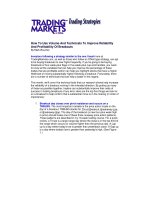Essentials of Investments: Chapter 9 - Behavioral Finance and Technical Analysis
Bạn đang xem bản rút gọn của tài liệu. Xem và tải ngay bản đầy đủ của tài liệu tại đây (1.64 MB, 30 trang )
Behavioral Finance and
Technical Analysis
Bodie, Kane, and Marcus
Essentials of Investments,
9th Edition
McGraw-Hill/Irwin
9
Copyright © 2013 by The McGraw-Hill Companies, Inc. All rights reserved.
9.1 Behavioral Critique
• Behavioral Finance
• Financial market model emphasizing potential
implications of psychological factors affecting
investor behavior
• Existence of irrational investors is not
sufficient to render capital markets
inefficient
9-2
9.1 Behavioral Finance
• Information Processing
• Forecasting errors
• People overvalue recent experience compared
to prior belief when forecasting
• Overconfidence
• People overestimate precision of beliefs or
forecasts, and overestimate abilities
9-3
9.1 Behavioral Finance
• Information Processing
• Conservatism bias
• Investors too slow in updating beliefs in
response to recent evidence
• Sample size neglect and representativeness
• People prone to believe small sample is
representative of population, infer patterns too
quickly
9-4
9.1 Behavioral Finance
• Behavioral Biases
• Framing
• Decisions affected by how choices are posed,
i.e. gains relative to low baseline level or
losses relative to higher baseline
• Mental accounting
• Form of framing; people segregate certain
decisions
9-5
9.1 Behavioral Finance
• Behavioral Biases
• Regret avoidance
• People blame themselves for unconventional
choices that turn out badly, avoid regret by
making conventional decisions
• Prospect theory
• Investor utility depends on gains/losses from
starting position, rather than levels of wealth
9-6
9.1 Behavioral Critique
• Limits to Arbitrage
• Fundamental risk
• Market changes or irrationality can eliminate
profits
• Implementation costs
• Exploiting overpricing is difficult; costs and
time limits can eliminate profits
• Model risk
• Inaccurate models generate inaccurate stock
values
9-7
Figure 9.1A Conventional Utility Function
9-8
Figure 9.1B Utility Function under Prospect Theory
9-9
9.1 Behavioral Critique
• Limits to Arbitrage and Law of One Price
• “Siamese twin” companies
• Dual-listed companies can appear to violate
Law of One Price
• Equity carve-outs
• Can violate Law of One Price due to inability to
short sell
9-10
9.1 Behavioral Critique
•
9-11
Figure 9.2 Pricing of Royal Dutch Relative to Shell
9-12
9.1 Behavioral Critique
• Bubbles and Behavioral Economics
• Evidence of irrational investor behavior
• Easier to identify once over
• Evaluating Behavioral Critique
• No coherent theory
• Most empirical support from one time period:
late ‘90s
9-13
9.2 Technical Analysis and Behavioral Finance
• Trends and Corrections
• Moving average
• Average price over given interval, interval
updated over time
• Attempts to identify underlying price directions
9-14
Figure 9.3 Share Price, 50-Day Moving Average for Intel
9-15
Figure 9.4 Moving Averages
9-16
Table 9.1 Stock Price History
9-17
9.2 Technical Analysis and Behavioral Finance
• Trends and Corrections
• Point and figure charts
• Traces significant upward/downward
movements in prices without regard to timing
• X denotes price increase, O denotes decrease
• Sell/Buy signals generated when stock
penetrates previous lows/highs
• Congestion area: Horizontal band of Xs/Os
created by price reversals
9-18
Figure 9.5 Point and Figure Chart for Table 9.1
9-19
Figure 9.6 Point and Figure Chart for Atlantic Richfield
9-20
9.2 Technical Analysis and Behavioral Finance
• Trends and Corrections
• Breadth
• Extent to which broad market index
movements affect individual stock prices
• Relative Strength
• Recent performance of given stock/industry
compared to that of broad market index
9-21
Figure 9.7 Market Diary
9-22
Table 9.2 Breadth
9-23
9.2 Technical Analysis and Behavioral Finance
• Sentiment Indicators
• Trin statistic
• Ratio of average volume in declining issues to
average volume in advancing issues
• Confidence index
• Ratio of top-rated corporate bond yield to
intermediate-grade bond yield
9-24
9.2 Technical Analysis and Behavioral Finance
• Sentiment Indicators
• Short interest
• Total number of shares currently short-sold in
market
• Put/call ratio
• Ratio of put options to call options outstanding
on stock
9-25









